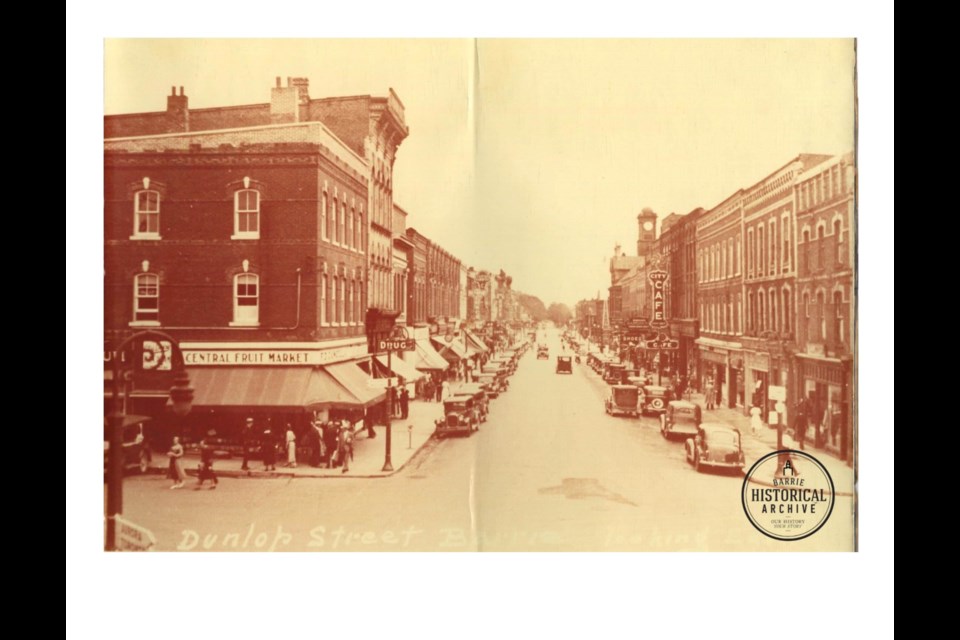The present-day location of Joshua’s Greenery at 35 Dunlop St. E. has seen many changes over the years.
As early as 1855, English-born tin smith, Aaron Burnett, was advertising his business at this place, although it is possible that he was working at his trade here as far back as the mid 1840s. At that time, his shop would have been a simple wooden structure.
Burnett left the spot by 1860 and he was followed by a succession of other tin and hardware men including, George Plaxton, John Plaxton (both relatives of Mrs. Aaron Burnett), Thomas Rawson and Patrick Moore.
During Thomas Rawson’s time in the venue, the disastrous Glebe Block fire of June 1871 occurred. The entire block from the current Meridian Place to Five Points on the south side of the street burned. Rawson’s loss was reported as $7,000 for his business and $2,000 for his home which was attached. Only a fraction of the value was insured.
By 1872, Rawson’s building was rebuilt, as were most of the brick buildings seen today along that stretch of Dunlop St. E. However, the financial burden of the renovation may have been too much to bear as Thomas Rawson auctioned off all of his stock in 1873 and moved his family out to Manitoba in 1874.
Patrick Moore, the last hardware man at 35 Dunlop St. E., took ill, left the shop and died in 1904 leaving no immediate successor in the place of business. W.A. Pae operated a dry goods store out of the building for a brief time and then sold to another dry goods merchant, George Vickers. Mr. Vickers never moved in and passed it on to the Carey Shoe Company which had previously been operating near the Queen’s Hotel.
For close to fifty years afterwards, 35 Dunlop St. E. would be familiar to Barrie consumers as a shoe shop.
In days gone by, and many of you will remember this, shoe shopping was an experience. Most footwear retailers were local shoe merchants as opposed to a chain. Everybody had their favourite. When the customer entered the store, they were greeted by a salesperson who sat them down, measured their feet and brought them box after box of shoes to try on until they found something they liked.
Possibly, the local footwear scene was just a little bit competitive as Mr. Johnston Carey alluded to in a series of newspaper ads just before and after the opening of his shop in 1909.
“The public would have been well stung if a bribe had been accepted to keep The Carey Shoe Co. out of Barrie.” Northern Advance, November 10, 1910.
In 1912, the Carey Shoe Company relocated to 35 Dunlop St. E. and hired Frank Hurlburt of Thornbury to manage their expanded operation. Five years later, Mr. Hurlburt bought out the Carey business and rebranded as the Hurlburt Shoe Company.
So successful was the enterprise that Frank Hurlburt managed to buy 35 Dunlop St. E. from the Plaxton family who had still retained ownership all those years. That same year, he began selling a shoe of his own invention, and called Hurlburt’s Cushion Sole Shoe. He had long admired a similar but more expensive item called Dr. Wirth’s Cushion Sole Shoe.
The manufacturing of this shoe to Hurlburt’s specifications was the job of the Weston Manufacturing Company. These more affordable, yet comfortable, items sold well in Hurlburt’s Barrie store, but soon caught the attention of another shoe maker who insisted that Hurlburt stop marketing them!
Since 1902, in Preston, Ontario, another footwear maker, known as the Hurlbut Company, had been making shoes and now objected to the rising fame of the similarly named Hurlburt Shoe Company in Barrie. They sued to have Frank Hurlburt’s trademark removed from the registry and to bar the Barrie company from using its founder’s name.
Hurlbut of Preston accused Hurlburt of Barrie of attempting to pass off their cushion shoes as ones made by them, a company that had some history and a good name in the business. They objected to the trademark design of a musket, bow and arrow that they felt too closely resembled their own family crest.
After seven years of litigation, Hurlburt of Barrie was allowed to carry on as usual. The court saw that it was unfair to ask a businessman to desist from using his own surname for his company, even if it sounded an awful lot like another business name.
Frank Hurlburt carried on at 35 Dunlop St. E. until his death in 1943. After that, another very old shoe company took over. The Robert Neill Company had been selling shoes and boots in Barrie since the 1850s.
The Neill Company undertook an extensive renovation of the building in 1948 which may have been the point where the once ornate Victorian exterior was altered to its rather plain look today. In 1958, the last of the shoes were sold in this place when Sterling Trust became the occupant.
Each week, the Barrie Historical Archive provides BarrieToday readers with a glimpse of the city’s past. This unique column features photos and stories from years gone by and is sure to appeal to the historian in each of us.



